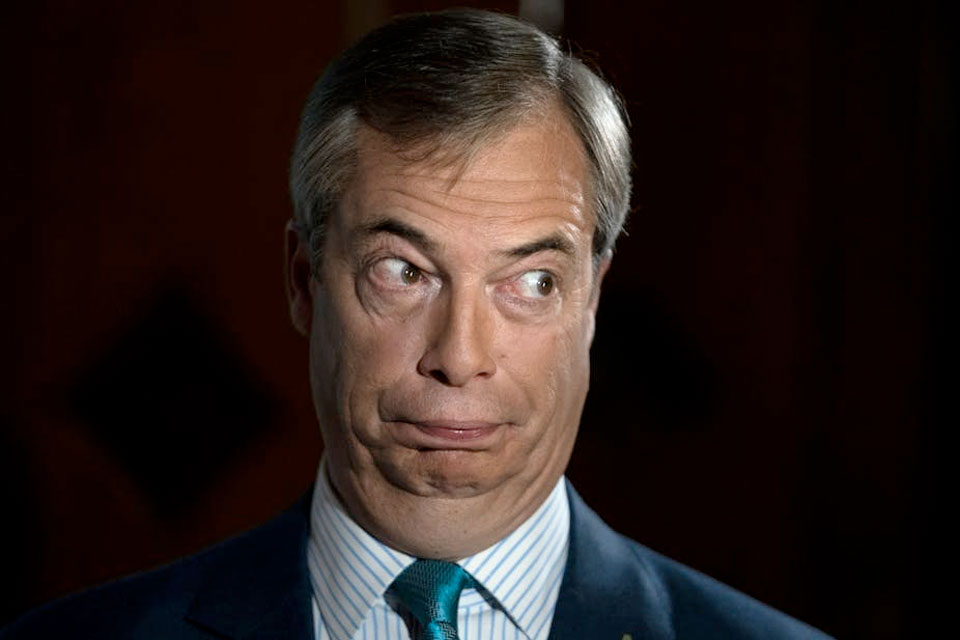Comment | How much of a threat is the Brexit Party to Boris Johnson and Jeremy Corbyn?

Nigel Farage says he’s coming for Labour votes but he’s probably still more of a threat to the Conservatives. EPA/Will Oliver
Gemma Loomes, Keele University
The Brexit Party has announced that it will not stand candidates in the 317 seats the Conservatives held at the last election, but will contest all the other constituencies in the country. Nigel Farage said his aim was to give Boris Johnson “half a chance” and avoid a second referendum.
Farage has reasserted his claim that the Brexit Party poses more of an electoral threat to Labour than the Conservatives – although he himself is not standing for a seat. Yet, the Conservatives believe that he has “effectively handed” several swing constituencies to Labour by splitting the Leave vote in those areas. This, the Conservatives fear, will undermine Boris Johnson’s ability to gain a majority. But who is right? Which side has more to fear from the Brexit Party?
Anti-European Union party UKIP and now the Brexit Party have occupied an unusual position in British politics because although they sit on the right of political spectrum, they threaten both the main political parties – on the right and left.
In the 2015 election, UKIP drew most of its support from people who voted Conservative in 2010 rather than those who voted for Labour. However, when we look at the demographics of UKIP’s support, some of the core of UKIP’s support comes from groups which are traditionally associated with the Labour Party – working class voters in the Midlands and the north and east of England with fewer formal qualifications.
And while UKIP did not deny David Cameron’s Conservatives a majority in that election, as had been predicted, the party did take 12.6% of the national vote.
Battling for the Leave vote
Now, the Brexit Party presents a clear and present danger to the Conservatives in 2019. It is the Conservatives’ main challenger on the centre-right of the political spectrum.
We cannot be certain of much in the forthcoming election, but we can be sure that the Brexit Party’s support will be formed almost exclusively of those who voted to Leave in the 2016 Brexit referendum. Around two-thirds of people who voted Conservative in 2017 were also Leave voters in 2016. Meanwhile, around two thirds of Labour voters in 2017 voted Remain in 2016. Simply put, in purely numerical terms, there are more Conservative Leave supporters than Labour Leave supporters.
That is not to say that the Brexit Party doesn’t pose a threat to Labour, though. The Brexit Party will seek to challenge Labour in its traditional northern heartlands, where Labour Leavers may be dissatisfied with their own party’s Brexit stance, but would never vote for the Conservatives.
Numerically, the threat is smaller but between 3m and 4m people who voted Labour in 2017 also voted Leave in 2016, and the Brexit Party will expect to take some of these votes in 2019.
Just 43% of Labour Leave voters intend to vote for Labour in 2019, with 25% intending to vote for the Brexit Party. This compares with 77% of Conservative Leave voters intending to vote for the Conservatives in 2019, and only 19% voting for the Brexit Party. So in terms of proportion of Leave voters, the impact of the Brexit Party will be felt by both parties.
The key factor shaping the national picture may be Labour’s position on Brexit rather than the Brexit Party itself. Labour will be squeezed on both sides. It could potentially lose over half its Leave supporters to other parties but it is also at risk of losing up to 42% of its Remain supporters to more clearly anti-Brexit rivals such as the Liberal Democrats.
Conversely, Conservative support appears to be holding more strongly, retaining the support of 77% of Leave supporters and 61% of Remain voters. Labour’s ambiguous position on Brexit may well cost it dear.
No uniform swing
In any general election it is impossible to make predictions about the outcome. In 2019 in particular, there is unlikely to be a uniform national swing and the factors at play in individual constituencies will likely shape the overall national result. For many voters, Brexit may not be the most important issue. The competing economic visions of the two main parties and support for individual candidates will still influence voting behaviour. Yet, Brexit remains the issue most voters consider the most important, so we can expect the Leave/Remain divide to be main fault line shaping the 2019 election.
Here, the Brexit Party poses a bigger threat to the Conservatives in pure numerical terms than to the Labour Party. But the Labour Party’s ambiguity on the Brexit issue may cost it support from both Leave and Remain supporters. The 2015 election showed that a eurosceptic party could win a large number of votes and still not be able to stop the Conservatives from forming a majority government. 2019 may see history repeat itself.

Gemma Loomes, Teaching Fellow in Comparative Politics, Keele University
This article is republished from The Conversation under a Creative Commons license. Read the original article.
Most read
- Keele ranks among England’s Top 15 universities for combined research and teaching excellence
- Reunion for Keele's 'pioneer' graduates
- Keele Professor receives Lifetime Achievement Award for significant impact on healthcare research
- Keele researcher awarded Academy of Medical Sciences funding
- Previously unknown details of aphids in flight will contribute to improved crop security
Contact us
Andy Cain,
Media Relations Manager
+44 1782 733857
Abby Swift,
Senior Communications Officer
+44 1782 734925
Adam Blakeman,
Press Officer
+44 7775 033274
Strategic Communications and Brand news@keele.ac.uk.

